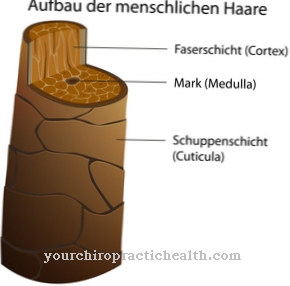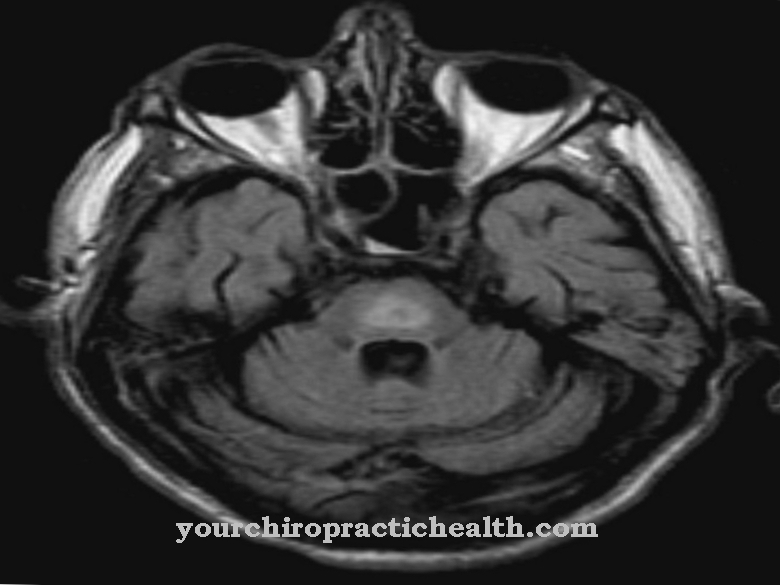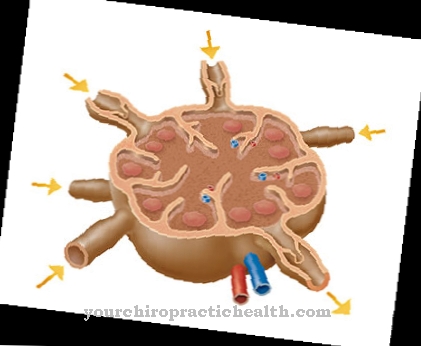The Scale syndrome is a nerve compression syndrome that belongs to the thoracic outlet syndromes. In the syndrome, the brachial plexus becomes wedged in the gap between the scalenus anterior and medius muscles. In the case of neurological deficits, the compressed nerve is surgically liberated.
What is the scale syndrome?

© SciePro - stock.adobe.com
The so-called bottleneck syndromes are a group of compression syndromes. In medicine, compression syndromes are diseases that go back to the jamming of an anatomical structure in a certain bottleneck in the body.
The Scale syndrome is a nerve compression syndrome in which the arm plexus Brachial plexus stuck in the so-called scalene gap. Of the Scalenus anterior muscle is a muscle between the cervical vertebrae and the ribs that, under certain circumstances, can constrict the arm nerve plexus. The scale syndrome will too Cervical rib syndrome or Naffziger Syndrome called.
Meanwhile, the clinical picture is summarized under the more comprehensive name Thoracic Outlet Syndrome. These syndromes are neurovascular compression syndromes of the upper thorax. Other nerve compression syndromes belonging to this group of diseases are hyperabduction syndrome, pectoralis minor syndrome, Paget von Schroetter syndrome and costoclavicular syndrome. The exact prevalence for the scale syndrome is not known. Overall, however, the thoracic outlet syndromes are considered to be relatively common.
causes
The cause of the scalene syndrome is compression of the brachial plexus. This arm's nerve plexus runs along the arms, shoulders, and chest. The anterior scalene muscle runs between the cervical vertebrae and the ribs. The area between the scalenus anterior muscle and the scalneus medius muscle is also known as the scalenus gap.
This point is a bottleneck for the brachial plexus especially if the patient has an additional cervical rib. Additional neck ribs are therefore one of the most common causes of the scalene syndrome. However, the cause of the syndrome does not necessarily have to be due to an excess of bony element, but can also be related to the muscle itself. For example, the muscle may be affected by muscle hypertrophy.
The resulting oversize of the muscle tissue can also force the arm nerve plexus into a tight spot. Another cause is a steepness or exostosis of the upper ribs, which can result in a severely narrowed scalenus gap. In the latter case, in addition to the strands of the brachial plexus, strands of the subclavian artery are also affected by compression. In certain circumstances, compression can also be associated with an excessive ligamentous system.
Symptoms, ailments & signs
The brachial plexus motor innervates the shoulder and chest muscles and is also involved in the motor and sensory innervation of the arm and hand. For this reason, patients with scalene syndrome typically suffer from stress-dependent neuralgiform pain in the shoulder and arm area, which manifests itself primarily in the ulnar forearm area.
Since the sensitive innervation of the hand is disturbed due to nerve compression, hypesthesia or paresthesia occur in the area of the hand. In some cases, these sensory disorders are associated with intermittent circulatory disorders, especially when the subclavian artery is compressed at the same time. Because of these circulatory disorders, the affected arm falls asleep more and more frequently.
Sometimes there is also a feeling of numbness and heaviness. In the later stage of a scalene syndrome, the patient can complain of paralysis of the arm and chest muscles, as the muscles in this area are motor-innervated by the compressed brachial plexus. From a certain stage onwards, increasing atrophy of the muscles due to paralysis is also conceivable, especially the small hand muscles.
In the advanced stages of the syndrome, narrowing of the subclavian artery also causes tiny blood clots to appear, which may block the finger vessels and thus discolour the fingers.
Diagnosis & course of disease
The diagnosis of a scalene syndrome is usually made by the doctor using a provocation test. Imaging of the chest may also be required as a diagnostic tool. In terms of differential diagnosis, the doctor must differentiate the syndrome from other thoracic outlet syndromes. The prognosis for patients with scale syndrome is generally favorable.
Complications
Patients with scalene syndrome typically suffer from exercise-related pain in the shoulder and arm area. These are usually associated with sensory disturbances and circulatory disorders, which can lead, for example, to restricted mobility and rarely also to the formation of blood clots. In the later stages of the disease, atrophy of the muscles can also occur.
The small hand muscles, which are less efficient due to the loss of tissue, are particularly affected and limit the person's daily tasks considerably. As the disease progresses, neurological deficits such as paralysis and movement disorders also occasionally appear. If these complaints are left untreated, permanent damage can remain on the compressed nerve plexus. In addition, thromboses occur, which block the finger vessels and discolour the fingers.
In pain therapy, the individual drugs can cause side effects and, under certain circumstances, major complications. If local anesthetics are injected, it can theoretically result in poisoning of the surrounding tissue. Associated with this are nervousness, dizziness and seizures. A drop in blood pressure and cardiac arrhythmia can also make themselves felt in rare cases. Surgical intervention carries the usual risks: infection, bleeding, nerve injuries and wound healing disorders.
When should you go to the doctor?
Medical treatment is always necessary in the case of the scalene syndrome. In most cases, there can be significant restrictions and complaints in everyday life. The scalene syndrome does not heal on its own. For this reason, a doctor should be consulted at the first signs, who can alleviate these symptoms. A doctor should be consulted if the person concerned suffers from severe pain in the arms or shoulders. This pain usually occurs for no particular reason and has a very negative effect on movement and also on the quality of life of the person concerned.
In many cases, disturbances of the blood circulation or sensory disturbances point to the scalene syndrome and should also be examined by a doctor. Feelings of numbness can also indicate the scalene syndrome. A doctor should also be consulted if blood clots form. The scalene syndrome can be recognized and treated by a general practitioner or an orthopedic surgeon.
Treatment & Therapy
With mild scalene syndromes, no further therapy is often necessary. In this case, the treatment focuses primarily on alleviating the pain symptoms. Such a mitigation can be achieved through conservative medical care of the patient. Most of the time, however, the main thing is to avoid the stress that causes pain. The patient does not have to be treated unnecessarily with painkillers.
In the case of pronounced pain symptoms, the pain is usually reduced by means of pain therapy. For example, local infiltration of the affected muscle with a local anesthetic is an option. Under certain circumstances, this therapeutic local anesthesia can also take place with the help of an implant that regularly delivers local anesthetics into the muscle.
If there are symptoms in addition to the pain symptoms, pain therapy is not sufficient to treat the scalene syndrome. This is especially true when neurological deficits such as paralysis arise. Surgical intervention may be indicated to restore the patient's mobility. The intervention should definitely take place before permanent damage occurs to the compressed nerve plexus.
The surgical intervention removes the primary cause of the compression. This therapeutic step often corresponds to the surgical removal of an additional neck rib, for example.
You can find your medication here
➔ Medicines for paresthesia and circulatory disordersprevention
The scalene syndrome cannot be prevented in the narrower sense, since the syndrome is most often caused by excess neck ribs. Such excess neck ribs are innate and cannot be avoided by taking active steps. However, the pain symptoms of the syndrome can be prevented insofar as pain-generating stress is avoided.
Aftercare
In most cases, the options and measures of follow-up care for the scalena syndrome are clearly limited. In any case, the patient is dependent on a quick and, above all, early diagnosis and treatment of this disease so that there are no complications or other complaints in the further course. The earlier a doctor is consulted in the case of the scalena syndrome, the better the further course of this disease will usually be.
Most of those affected are dependent on the measures of physiotherapy and physiotherapy with the scalene syndrome. Some of the exercises from these therapies can also be repeated in your own home, which speeds up healing. In many cases, it is also necessary to take various medications to alleviate the symptoms.
The person affected should always pay attention to the prescribed dosage and regular intake. If you want to have children, genetic testing and counseling can also be carried out. This can prevent this disease from occurring again. Further follow-up measures are usually not available to the person concerned.
You can do that yourself
In everyday life, care must be taken to ensure that no physical overexertion occurs. The body should be protected from overuse. The use of massages or regular warm baths is recommended to support the muscular system. Physiotherapeutic treatments are carried out if there are restrictions in movement. The person affected can also independently carry out exercises and training units they have learned to improve their own health outside of the specified therapy times.
Since thrombosis can develop, disturbances of the blood circulation must be prevented at an early stage. Rigid postures should therefore under no circumstances be adopted. If there are sensory disturbances in the skin or a tingling sensation on the skin, compensatory movements must be carried out immediately. Overall, getting enough exercise helps to strengthen the immune system and stimulate blood circulation.
The scalene syndrome is characterized by intense pain development. Although these complaints are treated with medication, it has been shown in many patients that strengthening the mental area can lead to a reduction in pain perception. It is therefore advisable to try out methods such as mental training, yoga or autogenic training. The techniques of the relaxation procedures described can also be integrated independently and independently at any time in everyday life by the person concerned. In addition, cognitive patterns are optimized and dealing with the disease is made easier.




.jpg)








.jpg)

.jpg)
.jpg)











.jpg)